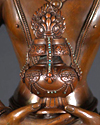This is an absolutely beautiful rendition of Shakayamuni Buddha encompassed by an exquisitely carved torana (archway). The amount of detail for such a small piece is just absolutely staggering! A true work of art!”
Brenda, Dharma Sculpture
Siddhartha Gautama was the son of Shakya King Buddhadana and Green Mahadevi. He was also called Buddha Shakyamuni or The Lion of the Shakya Clan. In the very center of this statue Buddha Shakyamuni is seen meditating in the “earth touching gesture” on an elaborate detailed carved lotus throne with a vajra carving. Below the vajra carving is a Naga (serpent). Nagas are the underworld guardians of treasures and concealed teachings. Shakyamuni is flanked by two of his chief disciples (arhats) namely Sariputra to his right and Maudgalyayana (also known as Moggallana) to his left representing the past and future Buddha. His face is serene and a peaceful aura surrounds him. His left hand is on his lap holding an alms bowl.
Lord Buddha is seated in front of a torana or archway. Toranas are extremely common in Nepali Newari art. As the ‘six-ornament’ enlightenment throne of the Buddha, its upper arch is decorated with mythological creatures, Garuda at its top and a pair of symmetrical Naga Kanyas and Makaras below. On its sides are a pair of young gods or devas, two hybrid antelopes or sharabha, two lions and two elephants.
As mentioned above, directly above Lord Buddha is an image of Garuda, the devourer of snakes. Garuda has a human upper body, large eyes, a beak, horns and hair that stands on end as well as bird’s claws and wings. Garuda is regarded as the deity that can cure snakebites, epilepsy and disease caused by Nagas. Garuda symbolizes the space element and the power of the sun, which can dry up the waters. Therefore Garuda is the natural enemy of snakes , which he devours or controls. It is said that Garuda can detect a snake at a distance, swooping down from the sky to seize and devour it. In a similar manner, Garuda, just like the mind’s spiritual energy, can detect the arising of a snake-like delusion and can eliminate it instantly without any obstruction.
To Garuda’s right and left are Naga Kanyas, (Snake Women). These engaging figures have a human torso and the body of a snake. The Nagas are serpents who in south and southeast Asian mythology are considered to be rain givers and guardians of the water and the riches of the deep. Naga Kanyas are the daughters of the Nagas. They are the goddesses of the three realms and pour their blessings of water on the worlds of the spirits, animals and humans. Though originally Hindu gods the figures of the Naga Kanyas were appropriated by Vajrayana Buddhism, images of Naga Kanyas appear in Tibetan, Nepalese and other tantric Buddhist art.
Below each of the Naga Kanya’s are Makaras, according to Buddhist tradition, these hybrids originated during the time immediately after the Buddha’s awakening when all hatred vanished from the world. During that time, animals that had been foe and prey mated with each other and produced such offspring as Makaras. Makaras have the lower jaw of a crocodile, the snout or trunk of an elephant, the tusks and ears of a wild boar, the darting eyes of a monkey, the scales and flexible body of a fish, and the swirling tail feathers of a peacock. They are the guardians of the toranas (gateways) and are a symbol of tenacious strength!
This sculpture is a one of a kind statue, handcrafted by the very talented artists of the beautiful Himalayan Kingdom of Nepal!
http://www.dharmasculpture.com/category/new-arrivals.html








